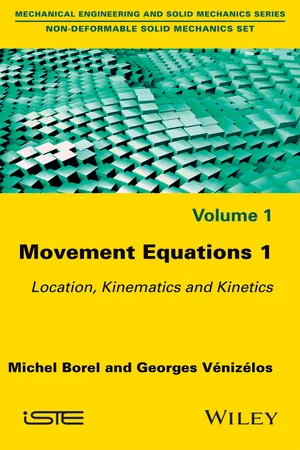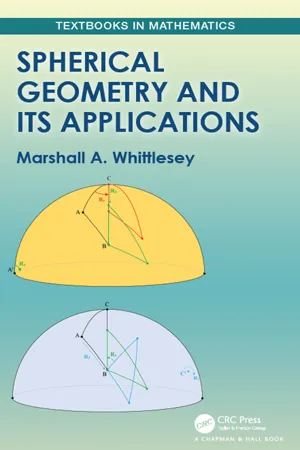Physics
Spherical Coordinates
Spherical coordinates are a system for locating points in three-dimensional space using radial distance, polar angle, and azimuthal angle. The radial distance is the distance from the origin, the polar angle measures the angle from the positive z-axis, and the azimuthal angle measures the angle from the positive x-axis in the xy-plane. These coordinates are useful for describing the position of objects in spherical symmetry.
Written by Perlego with AI-assistance
Related key terms
Related key terms
1 of 4
Related key terms
1 of 3
7 Key excerpts on "Spherical Coordinates"
- Chris B. Jones(Author)
- 2014(Publication Date)
- Routledge(Publisher)
Figure 4.1c ). This type of coordinate system is of use in cartography when plotting certain types of projection in which position can conveniently be defined relative to a single, central point, rather than a pair of axes. It is also relevant in general when it is appropriate to retain a sense of relative direction.In mathematical usage, polar coordinate angles are conventionally measured anticlockwise from a horizontal axis (Figure 4.1c ). In surveying and cartography, the angles are usually measured clockwise from a vertical axis, the angular units being either degrees (0-360) or grads (0-400), where 90° and 100 grads are equivalent to π/2 radians.For a given origin, a cartographic polar coordinate of r,θ can be expressed in rectangular coordinates using the trigonometric formulaex = ? r sin θ , ? y = r cos θ ?Conversely, the polar coordinates can be expressed in terms of the rectangular coordinates by finding θ from the relationshiptan θ = x / yso that θ can be found using the appropriate inverse tan function on a computer. Knowing θ,r ? = ? y / cos θ ?? ? ? ?We may also note thato r ? ? ? r = x / sin θ ?r 2 ? ? = ? ?x 2 ? ? + ? ?y 2Spherical Coordinates
We have seen that though planar coordinate systems are essential for constructing maps on flat surfaces, they cannot be used for representing extensive regions of the earth without introducing serious distortion in measurements such as distance and area. When high accuracy is not required these problems of distortion can be avoided by the use of a spherical coordinate system. This provides a single, consistent and relatively undistorted reference frame for recording positions and making measurements of the earth's surface. The coordinates can then be projected to a suitable planar coordinate system when a small-scale map of a particular region or aspect of the earth is required.- eBook - ePub
- Sivaji Chakravorti(Author)
- 2017(Publication Date)
- CRC Press(Publisher)
Figure 3.5 .As shown in Figure 3.5 , r is the distance from the pole to the projection of the point P on the polar plane, that is, the x–y plane passing through the pole, θ is the azimuthal angle, that is, the angle from the polar axis spinning around the z -axis in counter-clockwise direction, and z is the vertical height from the polar plane. The ranges of the values of the three coordinates are 0 ≤ r < ∞, 0 ≤ θ ≤ 2π and −∞ < z < ∞.FIGURE 3.5 Depiction of cylindrical coordinates of a point.In the cylindrical coordinate system, the three constant coordinate surfaces are defined by Equation 3.9f 1= r ,f 2= θ ,f 3= z ( 3.9 )Figure 3.6 shows the three constant coordinate surfaces in the cylindrical coordinate system. Out of these three surfaces, the first and the third surfaces, namely, f 1 = r and f 3 = z , are constant distance surfaces, whereas the second one, that is, f 2 = θ, is a constant angle surface. As shown in Figure 3.6 , the surfaces θ = constant and z = constant are planes, whereas the surface r = constant is a cylindrical surface.In this coordinate system, two unit vectors are defined on the x–y plane. The unit vector ûr points in the direction of increasing r , that is, radially outwards from the z -axis and the unit vector û θ points in the direction of increasing θ, that is, it points in the direction of the tangent to the circle of radius r in the counter-clockwise sense. The third unit vector ûz points in the direction of increasing z , that is, vertically upwards from the x–y plane. The unit vectors are shown in Figure 3.5 . The orthogonality of cylindrical coordinate system is defined by Equation 3.10 - eBook - ePub
Movement Equations 1
Location, Kinematics and Kinetics
- Michel Borel, Georges Vénizélos(Authors)
- 2016(Publication Date)
- Wiley-ISTE(Publisher)
S , which isThe angle is chosen as followsHence, we deduceand the expression of vectorUsing the relations established for α in cylindrical-polar coordinates, we obtainThe relations that express the Cartesian coordinates (x, y, z) as a function of Spherical Coordinates (R, α, β) are:NOTE 1.3.– It is considered by convention that1.3.3.4. General coordinates
It is also possible to locate the position in the system of reference ‹λ› of the point OS relative to Oλ with an arbitrary system of three parameters Q1 , Q2 , Q3 , which can be expressed asThe use of this system of coordinates is of particular interest in software applications, when the formalism developed in this manner is designed to apply to a high number of problems and to offer the possibility of choosing the system of coordinates to be used.An illustration of this case is provided by the example below, in which Oλ is located in the middle of the segment PN . Two groups of three parameters are thus obtained, (α, r1 , r2 ) and (α, α1 , α2 ), and they both allow for locating the point OS .This type of coordinate, called bifocal, is used in particular in the space domain. The angle α1 represents the 1st azimuth of the OS to be located.Figure 1.10.Example of general coordinates1.3.4. Exercises
1.3.4.1. Exercise 1 – Systems of coordinates
In the system of reference let M be a point identified by its Spherical Coordinates (R, α, β) which take the valuesQuestion: Determine the cylindrical-polar coordinates (R, α, z) and the Cartesian coordinates (x, y, z) of point M .Hence, we deduce that1.3.4.2. Exercise 2 – System of coordinates
In the system of reference let M be a point identified by its Cartesian coordinates (x, y, z) that take the valuesQuestion: Determine its cylindrical-polar coordinates (R, α, z) and then its Spherical Coordinates (R, α, β).According to the above figure, we also have Therefore, we obtain1.4. Positioning of a system of reference connected to a solid
- eBook - ePub
- Marshall Whittlesey(Author)
- 2019(Publication Date)
- Chapman and Hall/CRC(Publisher)
π is a matter of convenience. So a point in space does not have a unique set of Spherical Coordinates. However, we have the following theorem.Theorem 8.1 Suppose that (ϕ, θ) are polar coordinates for a sphere of radius r. Suppose that x, y, and z axes are chosen for space in the following manner. Let the center of the sphere be the origin. Let the positive z axis point in the direction of the pole of the coordinate system. Let the positive x axis point in the direction of the point (π 2, 0) and let the positive y axis point in the direction of the point (). Then a point A in space on the sphere of radius r with xyz coordinates (x, y, z) and polar coordinates (ϕ, θ) satisfiesπ 2,π 2(=x , y , z)(.r sin ϕ cos θ , r sin ϕ sin θ , r cos ϕ)(2.3) Proof.Figure 2.13: Theorem 8.1.The discussion above shows how every (ϕ, θ) determines a point A on the sphere. Let X, Y, and Z be the projections of the point A to the corresponding axes. Then ΔAZO is a right triangle with a right angle at Z. By definition of arc measure, m∠AOZ = mExercises §8, which is ϕ by definition. Since ΔAZO is a right triangle and the length of the segmentA P⌢is r, the coordinate of Z is r cos ϕ and the length ofO A¯is r sin ϕ. Thus z = r cos ϕ, as desired. Next, let W be the projection of A to the XY plane. Then the length ofA Z¯is the same as the length ofO W¯, which is r sin ϕ. The projections of W to the x and y axes are X and Y, respectively. Next, the absolute value of θ is the measure of planar angle ∠XOW. Then since W lies at radius r sin ϕ from O andA Z¯forms a signed angle of θ with the positive x axis, its xy coordinates must be x = r sin ϕ cos θ and y = r sin ϕ sin θ.O W¯1. Extend §6, Exercise 1c as follows: if a point X has latitude-longitude coordinates (a, b) with respect to some system of cooordinates on the sphere, then the distance c from X to the point with coordinates (0, 0) satisfies cos(c) = cos(a) cos(b - Benoit Beckers, Pierre Beckers(Authors)
- 2014(Publication Date)
- Wiley-ISTE(Publisher)
Q:[3.1]Figure 3.1. Notations used for Spherical CoordinatesAfter projection, the whole notion of distance from the center of projection disappears and what matters is only the direction in of the point.This direction is marked by two angles which, in cartography, are denoted by latitude α , which varies between −π/2 ≤ α ≤ π/2, and longitude φ , which varies in the range −π ≤ φ ≤ π. The definition of these angles requires the definition of a reference plane and therefore a great circle (the equator) and a reference point (the intersection of the equator and the Greenwich meridian). Meridians are great circles perpendicular to the equator. It finally remains to identify the two poles at the extremities of the diameter perpendicular to the equator.In the system of Spherical Coordinates, colatitude θ (or polar angle or zenith distance ) is preferred to latitude: θ = π /2 – α , with 0 ≤ θ ≤ π . The relationship between spherical and Cartesian coordinates is well known.[3.2]In astronomy, the position of a point on the celestial sphere is defined by the declination and the right ascension , respectively, equivalent to the latitude and longitude.The whole space can be represented on the picture, except one point: the projection center. In the non-oriented definition of the central projection, a point has two images: the two intersections with the spherical board. In the case of a spherical board, however, keeping the two images does not make much sense because it reproduces the scene twice. By adopting an oriented definition [3.1] in the projection on the sphere, the antipodal image and the induced topological rupture are deleted.- eBook - ePub
Orbitals
With Applications in Atomic Spectra
- Charles S McCaw(Author)
- 2015(Publication Date)
- ICP(Publisher)
Chapter 2Orbitals in the Hydrogen Atom
2.1Spherical Polar Coordinates
In the hydrogen atom, it is easiest to consider the nucleus to be at the centre of our right-handed coordinate system. We assume that the nucleus is a stationary point. Given the spherical symmetry of an isolated hydrogen atom, it is most practical to use spherical polar coordinates. These are illustrated in Figure 2.1 .r is the radial distance, which is always positive. The angles θ and φ are a little like latitude and longitude when considering locations on the globe (except they are measured in degrees and latitude is measured from the equator). In spherical polar coordinates θ is known as the colatitude and lies in the range 0 to π radians; φ is known as the azimuth angle and lies in the range 0 to 2π radians. They are related to Cartesian coordinates as follows:The inverse relations areA great advantage of using spherical polar coordinates to describe the hydrogen electron is that the wavefunction can factorise into a radial part, i.e. depending only on r, and an angular part, depending only on θ and φ, which simplifies calculations.Figure 2.1. The spherical polar coordinate system.2.2Degrees of Freedom and Quantum Numbers
Since the earliest spectroscopic experiments in the nineteenth century it has been evident that atoms absorb and emit energy in discrete amounts. (The first equation to describe the energy gaps in hydrogen atoms using what was effectively a quantum number was devised by the Swiss-German schoolmaster J.J. Balmer in 1885.) This caused terrible problems for classical mechanics, which couldn’t explain the results adequately.Some simple analogies using standing waves can illustrate the origin of quantum numbers. Let us consider the standing wave on a plucked guitar string. The standing wave can only have certain wavelengths due to the constraint that the string is fixed at each end. In wave mechanics such a constraint is known as a boundary condition. The lowest energy (or fundamental) note is when the length of the string is half a wavelength, i.e. the only points on the string where the amplitude is fixed at zero are at the ends. These zero points are known as nodes. Higher energy standing waves have shorter wavelengths. The next-highest energy wave, the first harmonic, has half the wavelength of the fundamental, so that a whole wavelength is held by the string and there is a third node half way along the string. In music, these harmonic differences are the octaves. The harmonic to higher energy has one third of the wavelength of the fundamental. It turns out that the energy of the allowed standing waves is a function of n − 1, where n is the number of nodes on the string. (n − 1 is used so the fundamental takes a value of 1 and harmonics are multiples of this.) n − 1 here is analogous to a quantum number and its origin lies in the boundary condition imposed on the standing wave.1 - eBook - ePub
- Nita H. Shah, Falguni S. Acharya(Authors)
- 2023(Publication Date)
- River Publishers(Publisher)
3 Sphere 3.1 Definition The sphere is a locus of a point that moves so that its distance from a fixed point always remains constant. The fixed point is called the center of the sphere and the constant distance is called the radius of the sphere. 3.2 Equation of Sphere in Vector Form Consider a sphere S with center C and radius ‘ a ’. Let P be any point on the sphere. Let c → and r → be the position vectors of C and P respectively with respect to O; the origin of reference. ∴ C P → = O P → − O C → ∴ C P → = r → − c → But. radius C P = | C P → | = a. (3.1) ∴ | r → − c → | = a (3.2) ∴ | r → − c → | 2 = a 2 ∴ (r → − c →). (r → − c →) = a 2 ∴ r →. r → − r →. c → − c →. r → + c →. c → = a 2 ∴. | r → | 2 − 2 r →. c → + | c → | 2 = a 2 ∴ | r → | 2 − 2 r →. c → + d = 0 ∴ | r → | 2 − 2 r →. c → = | c → | 2 = a 2 where d = | c → | 2 − a 2 is the equation of sphere in vector form. Case 1): If O lies on the sphere, then OC = OP; i.e., c. = a ⇒ d = 0 The Equation of sphere is | r → | 2 − 2 r →. c → = 0 Case 2): If the center C is at the origin O, then c = 0 and d = − a 2. ∴ Equation of sphere is | r → | 2 − 2 r →. c → = 0 | r → | 2 = a 2 | r → | = a. Equation of sphere in the cartesian form: Consider a sphere S with center C (α, β, γ), and radius ‘ a ’. Let P (x, y, z) be any point on the sphere. Let x → and c → be the position vector of P and C respectively with respect to O; the origin of reference. ∴ r → = x i → + y j → + z k → c → = α i → + β j → + γ k →. The equation in vector form. is | r → − c → | = a. ∴ | (x − α) i → + (y − β) j → + (x − γ) k → | = a ∴ (x − α) 2 + (y − β) 2 + (z − γ) 2 = a 2 which is the equation of sphere S in cartesian form with center C (α, β, γ), and radius ‘ a ’. Remark: When center C is origin. i.e., α = β = γ = 0 then the equation of the sphere is x 2 + y 2 + z 2 = a 2. 3.3 General Equation of the Sphere The general equation of the sphere
Index pages curate the most relevant extracts from our library of academic textbooks. They’ve been created using an in-house natural language model (NLM), each adding context and meaning to key research topics.
Explore more topic indexes
Explore more topic indexes
1 of 6
Explore more topic indexes
1 of 4






